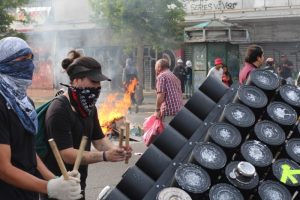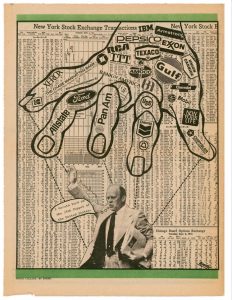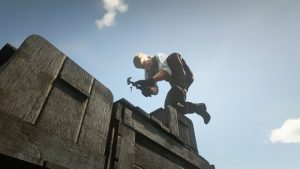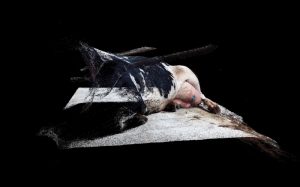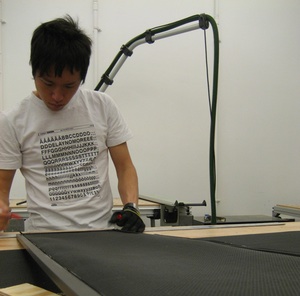 Justin Lui trained as an architect before earning an MFA degree from the UCLA Design | Media Arts in Los Angeles where i met him last Spring. He also has experience in web design, DJing and music production. He’s so versatile, i wouldn’t know whether i should define him as an interaction designer, media artist or architect. It probably doesn’t really matter. Justin Lui is developing programmed and interactive spaces that act at the scale of the spectator’s body. He is also part of Defectikons, a team of media artists with whom he has co-created media installations and music projects.
Justin Lui trained as an architect before earning an MFA degree from the UCLA Design | Media Arts in Los Angeles where i met him last Spring. He also has experience in web design, DJing and music production. He’s so versatile, i wouldn’t know whether i should define him as an interaction designer, media artist or architect. It probably doesn’t really matter. Justin Lui is developing programmed and interactive spaces that act at the scale of the spectator’s body. He is also part of Defectikons, a team of media artists with whom he has co-created media installations and music projects.
When we first talked to each other he had just dismantled the amazing Superficial Superglow: OPENINGS, a storefront installation facilitated by UCLA Architecture & Urban Design plus UCLA Design | Media Arts, which was built into the wall of the Los Angeles Contemporary Exhibitions gallery on Hollywood Blvd’s ‘Walk Of Fame’. The illuminated prototype glows in intensity according to the motion of passersby. On the street side, LCDs were displaying animated text remembering exhibitions culled from the 30-year history of LACE, while LCDs on the interior of the gallery showed text derived from artist Douglas McCulloh’s ‘60,000 Photographs in Hollywood’ describing characters encountered on Hollywood Blvd. Later on, when Justin told me about Animate Field, his MFA Thesis Project at UCLA Design | Media Arts, i thought it might be a good opportunity to interview him.
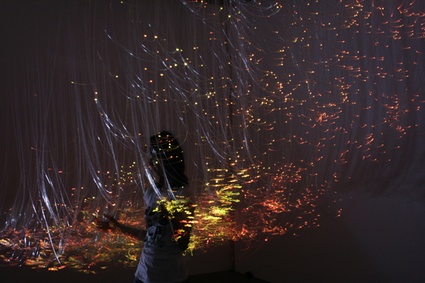 For your work Animate Field, a field of lights in direct contact with visitors’ skin, you used fiber-optic filaments. What are the new materials and technologies that you find most exciting and with which you’d like to work if money was no obstacle?
For your work Animate Field, a field of lights in direct contact with visitors’ skin, you used fiber-optic filaments. What are the new materials and technologies that you find most exciting and with which you’d like to work if money was no obstacle?
I think the first thing I would do with an expanded budget would be to expand the scale…! A project like Animate Field could really benefit from being enlarged to a more expansive field, to get closer to the infinite Ganzfeld-like spatial condition that James Turrell – for example – has in some of his work.
I’d also love to continue using the digital fabrication tools that were used in Superficial Superglow: OPENINGS, technologies such as CNC milling, vacuum-forming and 3D printing; all of which don’t come cheaply. Also, I’ve recently begun experimenting with bend sensors, so that might come into my work at some point. The opposite of a bend sensor is arguably muscle wire (shape memory alloy), which is a material I’d also like to explore.
So if money were no object, I would essentially put the money towards making my work more immersive, more formally engaging, and more tactile.
Animate Field from Justin Lui on Vimeo.
Animate Field requires the involvement of the body far more than your other installations. Is it something you are keen to explore even further?
Did you find that the audience was comfortable with the idea of walking through hanging bits of fiber-optic filaments? Or are people still slightly repelled and worried by a direct contact with technology?
Yeah, the direct bodily engagement of that piece was a bit of a left turn compared to my previous work, but I also see it as a continuation of earlier investigations. For example, Superficial Superglow: OPENINGS (and some prior projects) used bodily presence as a catalyst for interaction, but Animate Field added to that by incorporating the issue of direct contact with the body. This sense of touch is something I’d like to develop in future work, possibly with things like muscle wire and bend sensors.
About participation with Animate Field, I noticed that audiences were evenly split: older people tended to stay outside the cloud of fibers, while younger people (say, in their 20’s and younger) were much more open to wading into the fibers. The choice between observing from outside the thicket of fibers and participating inside it probably wasn’t about the fear vs. embrace of technology, as the fibers themselves looked more like a natural plant-like substance than something mechanical and intimidating. Instead, I just chalk it up to the participant’s sense curiosity vs. personal inhibition. What happened often was that one brave soul would enter the fiber cloud, play with the fibers, then others would follow inside – like a chain reaction. Sometimes it became a shared experience between strangers. I didn’t really anticipate this sort of sociability in Animate Field, but it was gratifying to see.
Another thing I observed was that the fibers would collect and stick together into branching structures after several days of having people pass through and comb them with their hands. At first I tried to ‘correct’ this by going in to the thicket to untangle the fibers, but I soon decided to let these forms accumulate because I realized that the installation wasn’t a defined discrete form (as designers are accustomed to creating), but instead was a set of conditions for a formal structure to emerge over time. It was a ‘socially generative’ formal mechanism as opposed to an explicitly designed form.
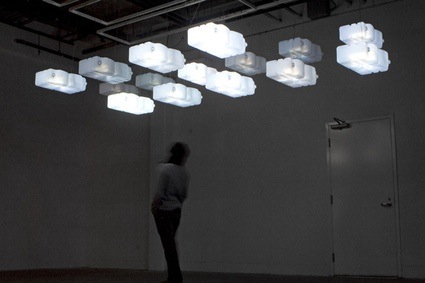 Water Clouds of Light
Water Clouds of Light
Water Clouds of Light looks like a remarkably simple installation. Some water jugs, a few light bulbs. Is the work really as straight-forward as i just made it sound?
Yes, I wanted it to have a clear and direct reading. It’s an unfussy installation; simple, serene, but not static as the lights ‘breathe’ in and out in a way that is life-like.
Compared to my other work, I think Water Clouds of Light stands apart in a couple of ways: it has a stated allusion to the natural world, and it runs autonomously as opposed to being specifically interactive (which some people found refreshing considering the contemporary disposition for interactivity and responsiveness).
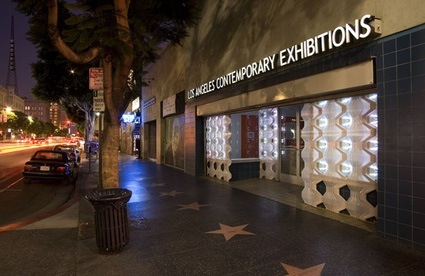 Superficial Superglow: OPENINGS
Superficial Superglow: OPENINGS
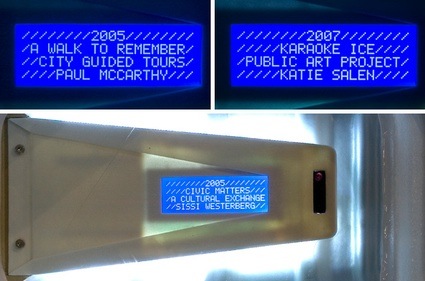 Superficial Superglow: OPENINGS
Superficial Superglow: OPENINGS
Many of the works in your portfolio have been devised for safe, closed exhibition spaces. Superficial Superglow: OPENINGS, however, was built into the exterior wall of an art gallery right on the famous Hollywood Blvd. Are you more comfortable in closed exhibition spaces or do you rather welcome the challenge of installing your work in contexts where you have less control over its surrounding (light, public, weather, etc)?
I see the value in both situations. A lot of my installations are dependent on the control of environment-related factors like light levels and physical access, so I like the degree of control in a gallery. But I also find that public spaces present an opportunity to engage a larger audience; one that isn’t pre-disposed to look for art, which means there’s a greater potential to surprise people (provided the piece has the conceptual clarity required to connect them in a meaningful way).
Since it was a double-sided installation, OPENINGS actually addressed audiences in both types of situations; gallery visitors inside Los Angeles Contemporary Exhibitions (LACE gallery), and passersby on Hollywood Blvd. The materials and construction were almost identical on both sides of the glass wall, but the experience on either side was different because the LCD data content was different for each side, and the sensors of the lighting-interaction system were exclusively aimed at the street to capture the movement of pedestrians.
There were some serious physical challenges on the exterior side, as you hinted at. With the security gate that rolled down every night, it was a tight and narrow space to build in to. Also, that area of Hollywood is a little bit seedy, so vandalism was always a concern. We actually had one of our ultra-sonic sensors stolen – twice!
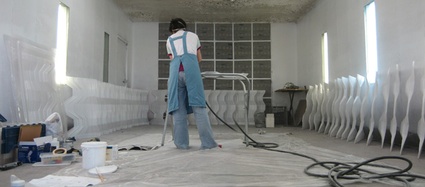
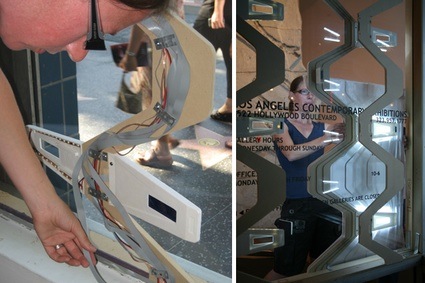 Superficial Superglow: OPENINGS (building process)
Superficial Superglow: OPENINGS (building process)
What have you learnt from the Superficial Superglow: OPENINGS experience?
That project was a great experience for me and my partners: Andrea Boeck and Jihyun Kim. The three of us formed a well-balanced and even-tempered team. I learned several things, including the value of maintaining that balance and good temper, and the importance of visual and conceptual clarity in a publicly-sited interactive piece. That was probably the most important thing, that interactive installations generally need to be designed and calibrated to express clearly to the participants what the interaction is; what they are being prompted to do, what the rewards or results are, etc. Clear communication, essentially.
Since the project was in a public space with a constant supply of test subjects, we were able to do some on-site testing and observe passersby triggering and relating to the interaction system. Consequently, we were able to tune the sensing, lighting and display systems to try to maximize the project’s ability to communicate and interact.
I also gained some valuable experience with managing and executing a fairly large interactive installation involving multiple technical systems and multiple outside parties (various UCLA departments, the gallery, suppliers, and so on).
Who are the artists or architects who inspire you today?
Creators of otherworldly atmospheres like Olafur Eliasson, James Turrell… Tara Donovan for the accumulative formal quality in her work… United Visual Artists, whose work represents to me an ideal marriage between behavioral electronics, physical space and people… realities:united, who also do great work combining electronic interaction and animation with physical architecture… Toyo Ito’s dynamic installations and structures from the late 1980’s and 1990’s, which pioneered a lot of the qualities I see in dynamic and interactive architecture today… Toshio Iwai, Tokujin Yoshioka, Scott Snibbe, and more.
You are also part of DEFECTIKONS::, a collective creating works that blend the architecture, design, visual art and sound disciplines. Can you tell me a few words about your role in DEFECTIKONS?
The Defectikons are a group of three partners; Chris McCullough and Shaheen Seth. I was one of two DJs, and I also shared the work on installation design and assembly, graphic design and music production. What happened fairly often was that I would work iteratively, refining things towards an end while the other two partners often created great beginnings.
Our media-installation projects were really fun and great to learn from. For us, they were a happy combination of architecture with DJing and video, like humble precursors to the Daft Punk pyramid.
At this point our creative energy has been refocused into a musical band, with the addition of two other members.
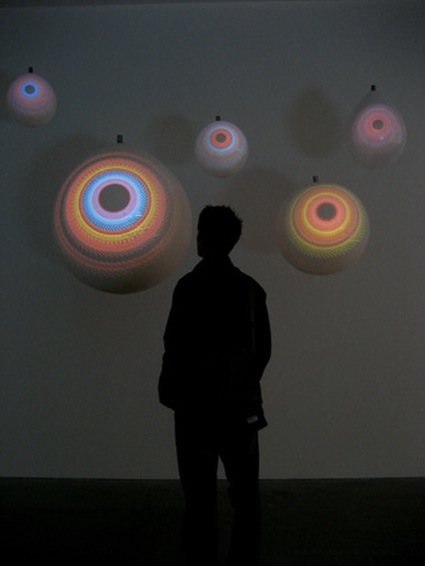 Speak & Spoil: The Ambiguity of Language
Speak & Spoil: The Ambiguity of Language
What have you been doing since I met you last Spring in Los Angeles?
Any project you could talk about?
I graduated from UCLA Design | Media Arts a few months ago, and have been working on various endeavors: teaching graphic design, web design, and physical computing; making project submissions with my OPENINGS partners; and showing Water Clouds of Light at a couple of light-art exhibitions. Next I’ll be working with Variate Labs and Miles Kemp (who co-wrote the book Interactive Architecture) to develop next-generation interfaces and interactive spatial architecture projects.
Thanks Justin!

